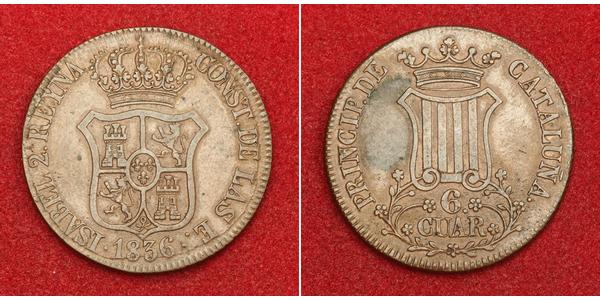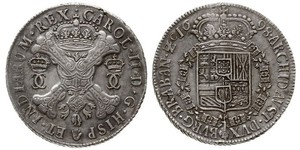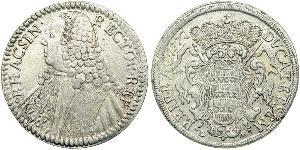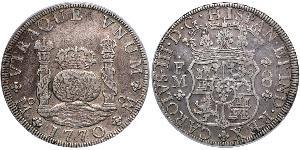(продана за $32.0)
1839, Spain, Catalonia (Province), Isabel II. Large Copper 6 Quartos Coin. XF+
Mint Year: 1839 Reference: KM-128. Condtion: Minor spots, otherwise a nice XF-AU! Denomination: 6 Quartos - Provincial issue for Catalonia. Weight: 14.03gm Material: Copper Diameter: 33mm
Obverse: Crowned coat-of-arms of Spain. Legend: ISABEL 2a . REYNA - CONST . DE LAS E . / 1836 .
Reverse: Royal crown above striped shield of Catalonia. Value (6. CUAR) within wreath of flowers below. Legend: PRINCIP . DE CATALUNA .
Isabella II (Spanish: Isabel II; 10 October 1830 – 10 April 1904) was the only Queen regnant of Spain in modern times. She came to the throne as an infant, but her succession was disputed by the Carlists, who refused to recognise a female sovereign, leading to the Carlist Wars. After a troubled reign, she was deposed in the Glorious Revolution of 1868, and formally abdicated in 1870. Her son Alfonso XII became king in 1874.
Isabella was born in Madrid in 1830, the eldest daughter of King Ferdinand VII of Spain, and of his fourth wife and niece, Maria Christina, who was a Neapolitan Bourbon. Maria Christina became regent on 29 September 1833, when her three-year old daughter Isabella was proclaimed queen regnant on the death of the king.
Isabella succeeded to the throne because Ferdinand VII had induced the Cortes Generales to help him set aside the Salic law, introduced by the Bourbons in the early 18th century, and to re-establish the older succession law of Spain. The first pretender, Ferdinand's brother Carlos, fought seven years during the minority of Isabella to dispute her title. Carlos' and his descendants' supporters were known as Carlists, and the fight over the succession was the subject of a number of Carlist Wars in the 19th century.
Isabella's reign was maintained only through the support of the army. The Cortes and the Moderate Liberals and Progressives reestablished constitutional and parliamentary government, dissolved the religious orders and confiscated their property (including that of Jesuits), and tried to restore order to Spain's finances. After the Carlist war, the regent, Maria Christina, resigned to make way for Baldomero Espartero, Prince of Vergara, the most successful and most popular Isabelline general. Espartero, a Progressive, remained regent for only two years.
Baldomero Espartero was turned out in 1843 by a military and political pronunciamiento led by Generals Leopoldo O'Donnell and Ramón María Narváez. They formed a cabinet, presided over by Joaquin Maria Lopez. This government induced the Cortes to declare Isabella of age at 13.
Three years later, on 10 October 1846, the Moderate Party (or Castilian Conservatives) made their sixteen-year-old queen marry her double-first cousin Francisco de Asís de Borbón (1822–1902), the same day that her younger sister, Infanta Luisa Fernanda, married Antoine d'Orléans, Duke of Montpensier.
The marriages suited France and Louis Philippe, King of the French, who as a result nearly quarrelled with Britain. However, the marriages were not happy; persistent rumour had it that few if any of Isabella's children were fathered by her king-consort, rumoured to be a homosexual. The Carlist party asserted that the heir-apparent to the throne, who later became Alfonso XII, had been fathered by a captain of the guard, Enrique Puig y Moltó.
Isabella directly reigned from 1843 to 1868, a period of palace intrigues, back-stairs and antechamber influences, barracks conspiracies, and military pronunciamientos to further the ends of the political parties — Moderados who ruled from 1846 to 1854, Progressives from 1854 to 1856, and Unión Liberals from 1856 to 1863. Moderados and Unión Liberals quickly succeeded each other and kept out the Progressives, thus sowing the seeds for the Revolution of 1868.
Queen Isabella often interfered in politics in a wayward, unprincipled way that made her very unpopular. She showed favour to her reactionary generals and statesmen and to the Church and religious orders. Other events of her reign were the war against Morocco (1859), which ended in a treaty advantageous for Spain and cession of some Moroccan territory; the fruitless Chincha Islands War against Peru and Chile; tensions with the United States; independence revolts in Cuba and Puerto Rico; and some progress in public works, especially railways, and a slight improvement in commerce and finance.
At the end of September 1868, Isabella went into exile, after her Moderado generals had made a slight show of resistance that was crushed at the Battle of Alcolea by Generals Serrano and Prim. This revolt, which deposed Isabella, is known as the Glorious Revolution, and ushered the First Spanish Republic into power. The new government replaced Isabella with Amadeo I, second son of Victor Emmanuel II of Italy, after much deliberation.
Her exile helped cause the Franco-Prussian War, as Napoleon III could not accept the possibility that a German, Prince Leopold of Hohenzollern-Sigmaringen, might replace Isabella, a dynast of the Spanish Bourbons and great-great-granddaughter of the French-born Philip V of Spain.
The First Spanish Republic collapsed in December 1874. Isabella had been induced to abdicate in Paris on 25 June 1870, in favour of her son, Alfonso XII, furthering the cause of the Restoration. After the collapse of the Republic, Alfonso was placed on the throne.
She had left her husband the previous March and continued to live in France after the restoration in 1874, in a small circle with the Marqués de Alta Villa as her secretary. On the occasion of one of her visits to Madrid during Alfonso XII's reign, she began to intrigue with the politicians of the capital, and was peremptorily requested to go abroad again. She resided in Paris for the rest of her life, seldom traveling abroad except for a few visits to Spain. During her exile, she grew closer to her husband, with whom she maintained an ambiguous friendship until his death in 1902. Her last days were marked by the matrimonial problems of her youngest daughter, Eulalia. She died on 10 April 1904, and is entombed in El Escorial.

|
Добавил:
anonymous 2018-06-19 |
4 Groschen Пруссия (королевство) (1701-1918) Серебро Фридрих ...
в группе 6 монет / 5 цен
⇑
















_(1701_1918)-300-150-sSshwJfl8_cAAAGL1F9TnYK4.jpg)






